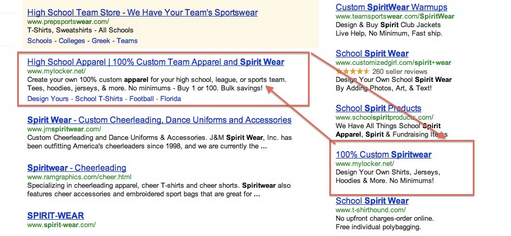
Most of us in the agency world frequently hear and even talk about the importance of blending organic search data with paid search data, but it seems that no one really knows what that means or how to do it. Nevertheless, aligning your paid campaigns and your organic efforts can have a quantifiable impact on your traffic. Indeed, according to a recent study conducted by Google, having a top paid listing, in conjunction with a top organic ranking leads to, on average, a 50% incremental increase in clicks.
Sounds great, but how do we actually get our campaigns and efforts aligned? Here are 4 things to consider:
- Don’t bid down on keywords just because you have a top ranking. Common thought is that the paid listing will cannibalize the organic listing, but the data and research actually shows that the opposite is true. Consider the fact that having the paid ad on top of (or adjacent to) your organic listing is giving you an additional piece of real estate on the SERP… So, your likelihood of getting the click is stronger.
- Use PPC Ad Creative to Shape Titles and Descriptions. The great thing about paid search is that it’s easy to test different messages and learn about what resonates with your audience quickly and easily. Take these findings, and apply them to your page title tags and meta descriptions so that your messaging is consistent, clear and crisp.
Take a look at the following SERP:  Notice how the messaging is consistent, and how the paid ad and organic listing both reinforce the same value propositions? This is a good way to build your brand story. Just keep in mind that the guidelines for PPC ad creative and on-page titles and meta descriptions are a bit different (which is a topic I’ll be covering in a future blog post).
Notice how the messaging is consistent, and how the paid ad and organic listing both reinforce the same value propositions? This is a good way to build your brand story. Just keep in mind that the guidelines for PPC ad creative and on-page titles and meta descriptions are a bit different (which is a topic I’ll be covering in a future blog post).
- ;Consider multi channel funnels and attribution. Remember, a click today may be a conversion tomorrow (or next week or next month). Use the attribution data provided to you in Acquisio as well as in tools such as Google Analytics (with multichannel funnels) to understand how paid and organic channels relate to each other. You might actually want to bid more aggressively on paid search terms that, on a last-click basis, appear to be underperformers if the attribution data suggests that the paid ad assists organic conversions, particularly on branded terms.
- Segment your analytics data. Then segment again. And again. And then segment some more! Google Analytics (and other analytics platforms too) make it incredibly easy to look at your paid data and your organic data side by side. Take a look at your top keywords, and see how the performance compares for each channel. Don’t just look at conversions and conversion rate though. Look at engagement metrics such as pages per visit, bounce rate, and average time spent on site as well. Major differences in any of these metrics between channels could indicate that the landing page or ad creative that you’re using in your paid campaigns might be different than what’s ranking organically. You can then switch the destination URL for the paid search keyword or your on page optimization strategy for the page that’s ranking organically to make sure you’re putting the best foot forward.
Obviously, implementing the tactics described can be time consuming, but the benefits to your campaigns (as well as your client’s level of satisfaction!) are well worth the cost.



